Can Outdoor Rugs Get Wet? Yes, But You Should...
Author: Rick Worst | Editor: Omar Alonso
Review & Research: Jen Worst & Chris Miller

Outdoor rugs are nice pieces of decor for your outer space. But you might be worried that leaving them unattended for a long period can make them wet or develop stains. So, can outdoor rugs get wet?
Unfortunately, outdoor rugs can get wet. But how much an outdoor rug gets wet depends on the material it’s made from. Natural materials like jute get more wet compared to synthetic materials such as Polyester or Polypropylene.
Keep on reading to find out more about the different types of materials that are used to make outdoor rugs and choose the right one for you. You’ll also learn how you can make the carpets free from getting wet and growing mold. Let’s dive in!
Can Outdoor Rugs Get Rained On?
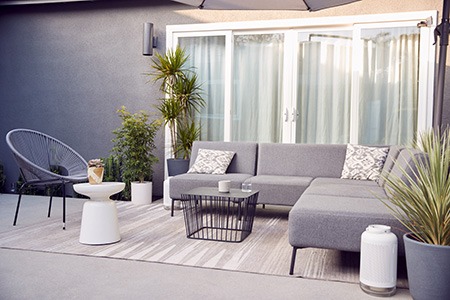
All outdoor rugs will get wet when it’s raining, regardless of which material it’s made from. Even if you’re using types of rugs made from a water-resistant material like polypropylene, it can still get a little wet.
But what separates a good rug from a bad one is its ability to deal with wetness. A well-made rug will be more durable and able to drain out most of the water and prevent mold growth. Some are designed to be able to become wet, so the right outdoor rug in rain is no problem. We discuss the materials to choose from below.
Are Outdoor Rugs Waterproof?
Most of the rugs that are made with natural fibers aren’t waterproof in any way. Water can easily pass through them and make them wet. That’s why mold growth is so common in such rugs.
Conversely, some synthetic fibers that are used to make rugs are water-resistant even though they’re not waterproof. The difference is that a waterproof material will be safe against water, whereas a water-resistant material will prevent water from getting in, but only to a certain degree.
If you're going to use a series of small or one large rug as a patio surface alternative to help decorate it and make it more comfortable to stand on, make sure you choose waterproof rugs.
Can You Use Outdoor Rugs Made from Natural Fibers?
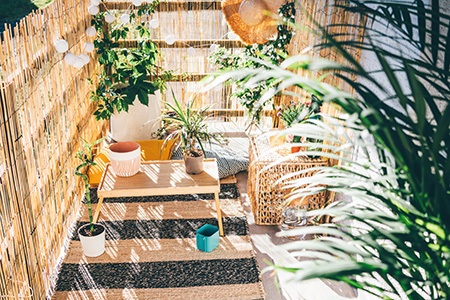
The outdoor rugs made from natural fibers are environment friendly, and they usually work better as a decoration piece compared to synthetic fibers. Such natural fibers include jute, sisal, seagrass, bamboo, and hemp.
But the main issue with the rugs made from natural fibers is the fact that they tend to hold moisture. That can easily lead to mold growth and also deteriorate in quality. You’ll also have to do a lot more maintenance work on such rugs.
There’s nothing stopping you from getting outdoor rugs made from natural fibers if you wish to do so. But if you want rugs that are durable and prevent mold growth, you’re better off getting ones that are made from synthetic fibers.
What Material Should You Choose for Your Outdoor Rug?
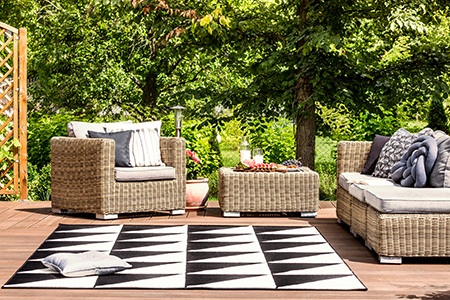
Synthetic material should be your material of choice when you want an outdoor rug. But there are many materials available even within the synthetic options. Here are some of the most popular ones:
Polypropylene
Polypropylene is one of the most common materials used for indoor and outdoor rugs, and there are many good reasons behind it. It’s an incredible man-made rug material that’s made from thermoplastic.
Polypropylene is durable, lightweight, resistant to moisture, easy to clean, and inexpensive. Moreover, you can wash it in the machine without causing any wear and tear to it. It’s also nontoxic for pets and works well on wood decks and concrete.
Additionally, you can choose Polypropylene if you want to design your rugs fashionably. It’s a flexible material that you can use with other rug materials to create a beautiful finish.
Acrylic
Outdoor rugs made from acrylic offer good resistance against mold and mildew growth. But it gets stained more easily compared to other synthetic materials and doesn’t do well with heavy foot traffic.
Polyester
Polyester is one of the most versatile materials in the world, and it’s extensively used in rugs. It’s a highly durable material that’s also easy to clean. If you want a rug that won’t stain easily, a Polyester one is the ideal one for you.
It doesn’t get damaged in the rain even with prolonged water exposure. And you’ll find polyester rugs in bright colors. They also do well against sunlight.
Nylon
Nylon is a great choice if you’re looking for synthetic fiber that’s also environment-friendly. Nylon is also water-resistant, durable, and can withstand rain, heavy foot traffic, and other outdoor elements. The only downside is that it’s more expensive compared to Polypropylene.
Note that acrylic, polyester, and nylon rugs can have some number of natural fibers in them. The right material for you depends on your requirements. Additionally, getting an outdoor rug that is UV resistant will protect it from wear and tear from direct sunlight and will last longer.
Do Outdoor Rugs Get Moldy?
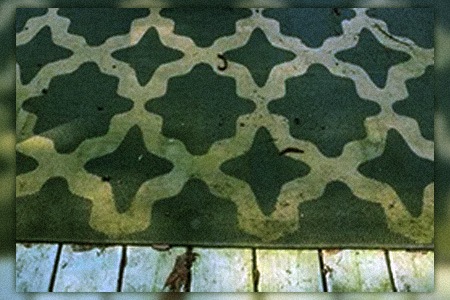
Outdoor rugs are constantly exposed to rain, food spills, pests, sun, and biological agents - all of these help the growth of mildew and mold. The rugs that are made with natural fibers can get moldy if you don’t care for them. However, synthetic rugs are mold-resistant and are the better choice for outdoor.
When you notice a musty or sour smell coming from the carpet, that’s a sign of mold growing in it. Rugs with mold growth can have a negative impact on people suffering from allergies, children, and pets.
Throw away the rug when there’s mold growth in it or have it professionally cleaned before you attempt to use it again. It’s a good idea to replace the outdoor rugs every two or three seasons or have them cleaned before the start of each season. Can outdoor rugs get wet? Yes, but even the ones designed for it will grow mold under them.
Some people don't use rugs and will use full blown carpeting on their patio. Can outdoor carpet get wet? Yes, many are designed to withstand it but you can guarantee that you'll have a mold problem in no time. Full blown carpeting outdoors is a bad idea, period.
How to Prevent Outdoor Rugs from Molding
To prevent mold growth in outdoor rugs, the ideal thing you can do is to keep them free from moisture. If you leave them in areas like a covered porch or deck, they won’t have too much exposure to the rain, snow, dew, and several other elements that could make it wet. That’ll protect them from molding.
Additionally, you can roll up the rugs and store them when they’re not in use, espeically, if you suspect heavy rainflow or snow. Try minimizing mold growth by cleaning it once a month. Keep the rugs in sunlight as well to prevent mold growth.
As you can see, it takes a lot of work to prevent outdoor rugs from molding. You’d need to take constant care of them. A much better way to go about it is to select a rug made from synthetic fibers rather than one with natural fibers. Polypropylene is an excellent water-resistant rug fiber that’ll prevent mold growth.
Do Wet Outdoor Rugs Leave a Stain Underneath?
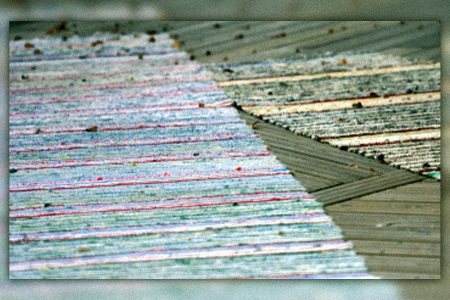
The outdoor rugs are most likely to get mold and leave stains underneath the carpet because of the mildew and mold growth. The most common indicator of mold growth in a rug is that you’ll see circular patterns of black, green, or brown stains on either side of it.
The synthetic outdoor rugs normally don’t get mold, but the area beneath them is likely to get it if it’s left wet for a long period. The chances of it happening increase significantly if you live in an area with high humidity. When that happens, you’ll see stains on the area underneath the rugs.
Can You Place Outdoor Rugs on Unsealed Concrete?
An outdoor rug can hide cracks in the concrete and add a nice touch to a patio. But is it safe to put on unsealed concrete? When you’re using an outdoor rug, it should ideally be put in sealed concrete.
But if you want to place an outdoor rug on unsealed concrete, your rug needs to be made from breathable materials to prevent mold growth. Use rugs made from synthetic fibers if you intend to use them on unsealed concrete without any concern.
How to Take Good Care of Your Outdoor Rugs
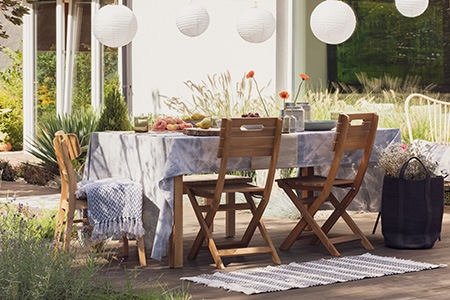
You can get your outdoor rugs to last for many years by taking care of them. The goal is simple - keep them as clean and dry as possible. If anyone spills food on the rug, clean it fast to prevent it from developing a stain.
When you clean your rugs, use products that are compatible with the materials for your rug. Don’t use cleaning products that have harsh chemicals. Vacuum your rug and hose it down once every week or month. The frequency of doing it depends on how much you eat or drink around it.
Having your rug cleaned before the start of each new spring and summer season will ensure that it lasts a long time. You can clean brightly colored synthetic rugs with vinegar and water. And use bleach with a dish soap solution to clean synthetic carpets that have one solid color.
Another important thing is to keep your rugs dry. Let it completely dry out on one side after heavy rain and flip it over to the other. It’s a good idea to roll the rugs and store them in a dry place to prevent them from fading due to direct exposure to the sun.
So Can Outdoor Rugs Get Wet & Be Okay?
Don’t waste your time thinking about if outdoor rugs can get wet or not. It’s clear that no matter which material your outdoor rug is made from, it can get wet. But synthetic materials are way better at resisting water and preventing mold growth.
By choosing the right material for your outdoor rug and cleaning it when required, you can use it for years to come and stop it from getting stained. So can outdoor rugs get wet? They can, given they're made to get wet.



